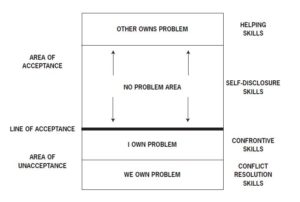Recall that your Behavior Window is made up of two areas: the Area of Acceptance and the Area of Unacceptance. You can place any behavior of your child in one of those two areas because you will either feel accepting or unaccepting of the behavior.
The Area of Acceptance can be further divided to represent two important and different types of behavior. First, your child can behave in a way that does not cause you a problem and that does not signal that your child is experiencing a problem (e.g. your child is watching and enjoying her favorite TV program); in short, there is no problem in the relationship. We place these behaviors in the No Problem Area, a part of your Area of Acceptance.
Also in your Area of Acceptance are behaviors of your child that don’t cause you a problem but indicate that the child is experiencing a problem.
Examples:
- You see your son sobbing quietly while staring blankly at the TV.
- You hear your daughter complaining about being bullied at school.
- You see your son throw down a LEGO™ set he has been building and say “I can’t do anything right!”
If you feel accepting of these behaviors, they fall in the area: Child Owns a Problem; the child is experiencing the problem; it is happening to him or her; it is his or her problem, not yours; your child’s needs are not being met. You see that s/he is feeling distress.
When your child is upset, crying or complaining about something, it is very hard as a parent to resist taking on your child’s problem as your problem. You feel bad; you want to help. Instead of taking on and solving your child’s problem for them, in P.E.T. you will learn skills to show you care and how to actively help your child solve his/her own problems.
You can be very concerned for your child and want to help him/her work out a problem without you “owning” that problem yourself. In P.E.T., you’ll learn how to help your child when she or he is “owning” a problem and wants your support.
Below your line of acceptance are behaviors of your child that cause you a problem; now it is your needs that are not being met; it is you that is experiencing an upset, a feeling of frustration, worry, discomfort, etc. You Own the Problem when you feel unaccepting of your child’s behavior.
Examples:
- Your child is playing her music so loudly you can’t get to sleep.
- Your four-year-old child is writing on the walls with a felt-tip marker.
- Your teenager said s/he would be home at 11:00 p.m. and it is now 12:15 p.m.
You’ll learn skills in P.E.T. for giving yourself some relief when you are “owning” the problem.
Also below your line of acceptance is the area called “Both Own Problem”. In these situations, your child’s behavior is unacceptable to you, but that behavior is an indication that your child also has a problem. The two of you have a conflict of needs and/or solutions. In P.E.T. you will learn specific problem solving skills to deal with these situations.

